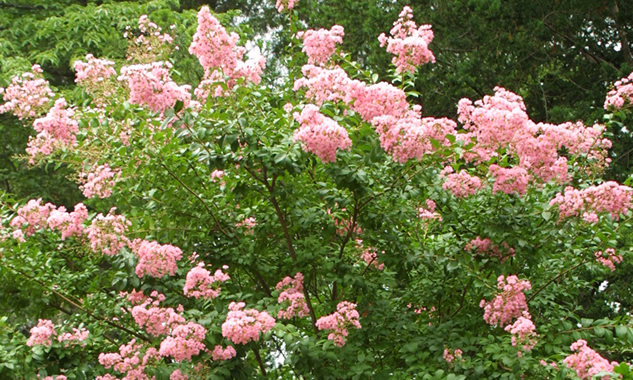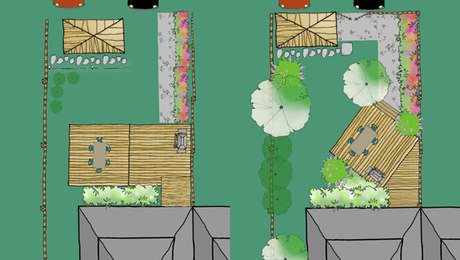Douglas W. Tallamy is professor and chair of the Department of Entomology and Wildlife Ecology at the University of Delaware in Newark. He has written more than 65 research articles and has taught courses in insect taxonomy, behavioral ecology, and other subjects. Chief among his research goals is to better understand the many ways that insects interact with plants and how such interactions determine the diversity of animal communities.
1. Is there any place for non-native ornamentals in my garden (as long as they are not currently considered invasive)?

Photo/Illustration: Michelle Gervais
We have always known that gardens are for our enjoyment; it is only recently that we have recognized their important ecological role, as well. Is it possible to rebuild ecosystem function in your landscape and still include some non-native ornamentals? Of course, but to do that, you need to understand what each plant species is contributing to your local ecosystem.
Crape myrtle (Lagerstroemia spp. and cvs., USDA Hardiness Zones 7–9), for example, is an enormously popular landscape plant because it has a nice habit, beautiful flowers, and lovely bark. But it contributes almost nothing to the food webs in your garden. If every plant in your yard were a crape myrtle, you would have no food webs and, thus, no birds, butterflies, or other beneficial wildlife. Does that mean you can’t have one or two crape myrtles? No. Right now, though, about 80 percent of the plants in our suburban landscapes are Asian ornamentals, like crape myrtle. We need to balance the number of decorative plants in our gardens with plants that are contributing in ecologically important ways; otherwise, we will have beautiful but sterile landscapes.
2. What are your views on cultivars of native plants?
Pamela Daugherty, Evansville, Indiana
There are no thorough studies comparing natives to their cultivars that I know of, but I can make some predictions. Because insects that eat leaves select host plants based on leaf chemistry, we can predict how they will do on cultivars by predicting how much the leaf chemistry was changed during the creation of the cultivar.
Many cultivars are natural variants that were found in nature and then brought into cultivation. These should be just as productive as the straight species because there was no active breeding program that might have changed the leaf chemistry. If a cultivar is bred to be fat instead of skinny (or bred for any shape change), I doubt if leaf chemistry would have changed much and so it should be just as productive. If leaf color is changed (a green leaf turned into a purple or variegated leaf), however, then the leaf chemistry is undoubtedly changed. Purple leaves are loaded with anthocyanins, chemicals that deter insect feeding. Variegated leaves have less chlorophyll and are probably less nutritious. Such cultivars are likely to be less productive in terms of supporting insect herbivores.
Most cultivars focus on flowers, making them larger or changing their color. These probably have an impact on pollinators, particularly if the genetic change results in less nectar or pollen production, as it often does. Another feature of cultivars is that they are usually propagated clonally. We know that loading the landscape with plants that have no genetic variation is not a good idea.
Having said all of that, if your choice is between a cultivar of a local native plant and a plant from Asia, I would always take the native cultivar.
3. Many catalogs offered gooseberries this year. I’m trying two here in mid-Tennessee and even had one berry in July. I planted them in semishade to avoid leaf scorch. My concern is white pine blister rust or cedar apple rust, which might occur with plants in the Ribes genus. I’ve heard that newer types of gooseberry are less likely to host this disease. Is this true, or should I pull my gooseberries out of my diverse garden?
Scotty Sutherland, Cookeville, Tennessee
Most Ribes species are part of the life cycle of white pine blister rust, and we don’t want to encourage the spread of that disease. (Ribes species do not serve as host for cedar apple rust.) But there are some resistant varieties of Ribes that don’t support the disease; one of the best is ‘Consort’, so feel free to use that in your garden.
4. What percentage of a garden should be devoted to plants that are solely there for the purpose of providing wildlife with food or refuge?
Barbara Summit, Glenwood Springs, Colorado
This will depend on your personal goals. Every time that you add a productive native plant to your landscape you improve your local food web. Generally speaking, woody plants support more animal species than annuals or perennials, but flowering plants are vital to our pollinators. The important thing is to get more plants of both types into our gardens. Most landscapes in our eastern suburbs are more than 90 percent lawn, which provides neither food nor shelter for most species.
Fine Gardening Recommended Products

A.M. Leonard Deluxe Soil Knife & Leather Sheath Combo
Fine Gardening receives a commission for items purchased through links on this site, including Amazon Associates and other affiliate advertising programs.


















Comments
When it comes to hosting native insects, will a hybrid oak like a Bebb's Oak (Bur x White), offer the "dual" benefits of a White Oak AND a Bur Oak, or would it behave more like an "alien" since it's a hybrid?
Log in or create an account to post a comment.
Sign up Log in